Learn to Drive
Driving lesson brief 14. Progressive driving
Introduction
Progressive driving is about making maximum progress for the road, traffic and weather conditions without risking safety. This requires more driving skill and better planning and awareness, particularly when you are overtaking or negotiating bends in the road.
Two of the most dangerous and difficult manoeuvres that you can undertake in driving are overtaking fast moving traffic on a two-way single carriageway and negotiating bends at speed. Therefore the aim of this lesson is to help you learn how to control the car at speed, negotiate bends and to overtake safely when the opportunity arises.
![]() Lesson objectives
Lesson objectives
By the end of this lesson you should be able to:
- Explain the difference between progressive driving and speeding
- Explain the conditions that are likely to result in a skid and loss of control of the vehicle
- Consistently drive at such a speed that you can stop within the distance you can see to be clear
- Explain what factors need to be considered when assessing how fast a bend can safely be negotiated and the risks involved
- Identify the sharpness of a bend on approach and therefore the most suitable speed and gear to negotiate the bend
- Demonstrate a reasonable level of skill in negotiating bends of differing shapes and complexity
- Explain the likely places it would be unsafe to overtake and why
- Demonstrate a reasonable level of skill in overtaking moving vehicles at speed on a single two way carriageway
Lesson brief
Progressive driving is about making maximum progress for the road and weather conditions. It is about minimizing your journey time without risking safety. During this lesson you will learn, how to overtake speeding vehicles on a single carriageway, how to negotiate bends at speed and also how to recognize when speed, can result in a waste of time, energy and fuel.
There is one golden rule about speed - never drive beyond the limits of your vision - always drive at such a speed that you can stop safely within the distance you can see to be clear.
Speed versus progress
Speed does not necessarily equal progress. For example when you are proceeding in a constant flow of traffic that has few significant gaps there is little point in racing to overtake at every opportunity you get as your progress will continually be hindered by the overall flow of the traffic.
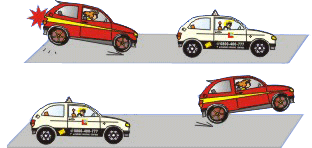 You would be constantly slowing down and accelerating throughout the journey to save a few minutes out of a 60 minute journey time. The fuel you would use on such a journey would potentially be doubled and your energy would be sapped from all the extra concentration you would need to cope with the overtaking and the constant changes of speed.
You would be constantly slowing down and accelerating throughout the journey to save a few minutes out of a 60 minute journey time. The fuel you would use on such a journey would potentially be doubled and your energy would be sapped from all the extra concentration you would need to cope with the overtaking and the constant changes of speed.
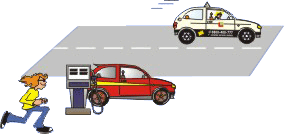 Therefore the progressive driver uses his or her brain and does not waste fuel or energy for little or no gain in overall journey times. One extra stop for fuel would loose any gain you might make.
Therefore the progressive driver uses his or her brain and does not waste fuel or energy for little or no gain in overall journey times. One extra stop for fuel would loose any gain you might make.
Keeping a grip
When driving at speed road and tyre adhesion become critical. Therefore anything that will influence this adhesion must be considered when you are driving. Tyre tread, tyre pressure and the cars suspension all affect the cars ability to stop or take corners at speed.
Changes in the road surface also play a major role. Wet leaves, mud, oil, ice and water on the surface of the road all affect adhesion as does the actual material make up of the road surface itself. Certain road surface materials give a better grip. Changes in the way the road inclines can also affect adhesion particularly on corners. All the above need to be carefully considered if you want to make maximum progress without compromising safety.
Driving round the bend
There is a lot of skill and balance needed to make maximum progress round bends. However, the first thing to remember is the golden rule. Just because you can take a bend at 50 mph doesn’t mean that you should, especially, if you cannot see what's around the corner. You may discover a steam roller, a combine harvester or an articulated lorry waiting for you!
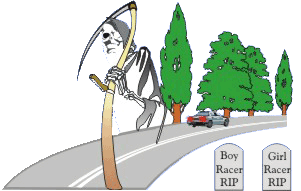 When approaching a bend you need to consider; the shape of the bend, what you can see ahead, what's on the roads surface (and does it incline in anyway) and finally what you will hit if you lose control. If there are trees along the road and you are pushing the car and/or your own ability to its limits then you are dicing with death. Bends take many “boy and girl racers” lives.
When approaching a bend you need to consider; the shape of the bend, what you can see ahead, what's on the roads surface (and does it incline in anyway) and finally what you will hit if you lose control. If there are trees along the road and you are pushing the car and/or your own ability to its limits then you are dicing with death. Bends take many “boy and girl racers” lives.
Balance
The first thing that you need to learn to successfully negotiate bends at speed is balance. The vehicle achieves maximum adhesion when the weight of the car is evenly spread over each wheel and across the whole of the tread of the tyres . As soon as you brake or turn the weight of the car shifts such that adhesion may primarily be occurring on only one or two of the wheels tyres and, if the wheels lock, only across part of the tyres tread. This dramatically increases the risk of a skid (i.e. the loss of adhesion) and makes the car very unstable.
Therefore you should not be braking or accelerating at the point you enter the bend. Ideally you should maintain a constant speed into and around the bend. As you come out of the bend you can begin to accelerate.
Sensitivity
 When you turn your steering wheel it should be done gradually and smoothly without jerking. You are trying to minimize the sharpness of the curve you are turning without cutting across to the other side of the road or allowing your road position to become a hazard to oncoming vehicles. On approach to the hazard (i.e. the bend) you should properly apply your hazard drill making sure you are at the right speed and gear before you start to turn.
When you turn your steering wheel it should be done gradually and smoothly without jerking. You are trying to minimize the sharpness of the curve you are turning without cutting across to the other side of the road or allowing your road position to become a hazard to oncoming vehicles. On approach to the hazard (i.e. the bend) you should properly apply your hazard drill making sure you are at the right speed and gear before you start to turn.
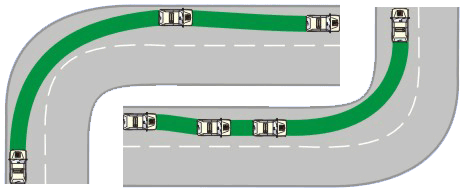
Overtaking at speed on single carriageways
Overtaking moving vehicles at speed on a single carriageway is potentially the most dangerous manoeuvre you can perform. You are driving on the wrong side of the road while traffic may be heading towards you.
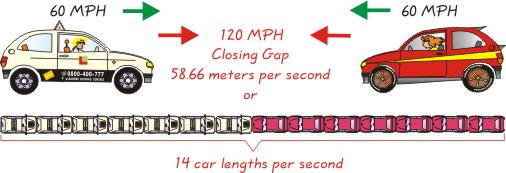
Choosing a safe place to overtake
Perhaps the most important thing to learn about overtaking is where not to overtake. You should never normally overtake immediately after a warning sign, in particular if it is one of those shown below:

You need to look well ahead for these hazards and road markings.
One physical hazard that is not easy to spot is something termed “Dead Ground”. This is where the road dips into a hollow such that it can give you the illusion that there are no oncoming vehicles when in fact there are.

There are two important points to learn from this. Firstly, if your view ahead is not absolutely clear wait and secondly; always be prepared to brake and abort the overtake, if necessary.
Never ‘follow through’
You may occasionally find yourself in a stream of vehicles, all of which intend to overtake a slow moving vehicle. Make sure that you can see clearly ahead before overtaking in this situation. Never ‘blindly’ follow the vehicle ahead assuming that it is safe.
The overtaking procedure
The overtaking procedure is similar to that covered on the dual carriageway lesson, however, we now have to consider oncoming traffic. Again you would probably use the hazard drill at least 3 times as shown below:
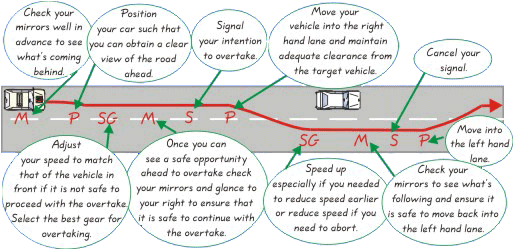
Highway code practical references
Rules: 103, 113-115, 121, 127-129, 154, 164-169, 274, 276-287
Page: 117